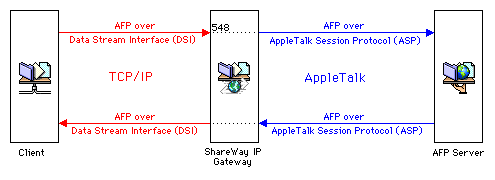
Figure 1. How ShareWay IP works
File Sharing
The ShareWay IP Gateway only implements a very small part of the AppleTalk Filing Protocol (AFP). For the most part, ShareWay IP simply translates the underlying AppleTalk protocols used by most AFP servers into TCP/IP, the protocols used on the Internet. In technical terms, the gateway translates ASP (AppleTalk Session Protocol) over AppleTalk to Apple's Data Stream Interface (DSI) over TCP/IP and vice versa. See Figure 1 below. DSI was introduced with AppleShare IP 5.0. For more information on DSI, refer to AFP 2.2 Specification, Apple Computer.
Like AppleShare IP, ShareWay IP uses TCP port number 548 by default to communicate with AppleShare Client 3.7, although other port numbers can be specified (see Target Server IP Address Dialog in ShareWay IP Windows). If your network has a firewall between ShareWay IP and the Internet, and you wish a target server to be accessible from the Internet, remember to allow access through that firewall to the port number that ShareWay IP uses for that server.

Figure 1. How ShareWay IP works
If ShareWay IP and the server are on the same Macintosh, the indicated communication between ShareWay IP and the server over AppleTalk is internal to the machine on which they are installed.
In addition to translating between AppleTalk and TCP/IP protocols, ShareWay IP also mimics other aspects of AFP servers. For instance, if it detects a loss of connectivity with either the client or the server, ShareWay IP will wait two minutes before terminating the session with the other end.
SLP Registration & Proxy
Service Location Protocol (SLP) is an Internet-standard protocol which enables network services to make themselves known so they can be found dynamically on a TCP/IP network. It is similar in concept to servers registering with AppleTalk and the Chooser being able to locate them. SLP is implemented in Mac OS 8.5 as the system extension "SLPPlugin".
Running on Mac OS 8.5 or later, ShareWay IP Pro 2.0 registers targeted servers and proxied-for servers with the Mac OS using SLP. Registration is automatic, and transparent to the user. For each server targeted by ShareWay IP, ShareWay registers a URL of the form:
afp://IP-address:port/?NAME=TargetMachineName&ZONE=ZoneName
IP-address is the IP address assigned by ShareWay IP to the target server
port (optional) is the port number assigned by ShareWay IP to the target server; if omitted, the default port number 548 is assumed
TargetMachineName is the target server's name
ZoneName (optional) is the name of the zone (if zones are present) in which the target server resides
For each server proxied for by ShareWay IP, ShareWay registers a URL of the form:
afp://IP-address:port/?NAME=SLPProxyName&ZONE=SLP%20Proxy
IP-address is the IP address of the server being proxied for
port (optional) is the port number used by the server being proxied for; if omitted, the default port number 548 is assumed
SLPProxyName is the name registered with SLP for the proxied-for server
"SLP%20Proxy" is the zone name used for all SLP proxy registrations - the "%20" is the URL-standard encoded form of a space. AFP Engage! will decode "%20" and display it as a space, as in "SLP Proxy".
ShareWay IP registers and deregisters servers with SLP according to the following criteria:
| Targeted Servers | Proxied-for servers | |
| Register when |
|
|
| Deregister when |
|
|
Table 1. SLP Registration & Deregistration
Registered URLs are used by Open Door's AFP Engage! 2.0 to dynamically find, display and initiate access to targeted and proxied-for servers, using a Chooser-like point-and-click interface. Note that although connections to targeted servers go through ShareWay IP, connections to proxied servers do not. ShareWay's only role in proxying for servers is to register an IP address and server name with SLP.
To prevent targeted servers from showing up in AFP Engage!'s Browse window, simply disable the SLP plug-in on the ShareWay IP machine, using the Extensions Manager Control Panel. Note that doing so also disables ShareWay IP Pro's SLP proxy feature.
For more information on the Service Location Protocol, see Open Door's white paper on the subject, and the RFC.
![]() Back to Table of Contents
Back to Table of Contents
![]() Back to Connecting to ShareWay IP
Back to Connecting to ShareWay IP
![]() Forward to Troubleshooting
Forward to Troubleshooting